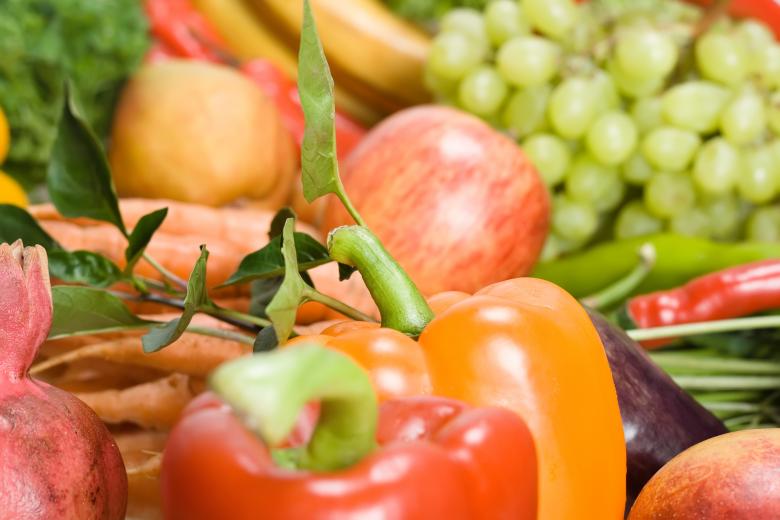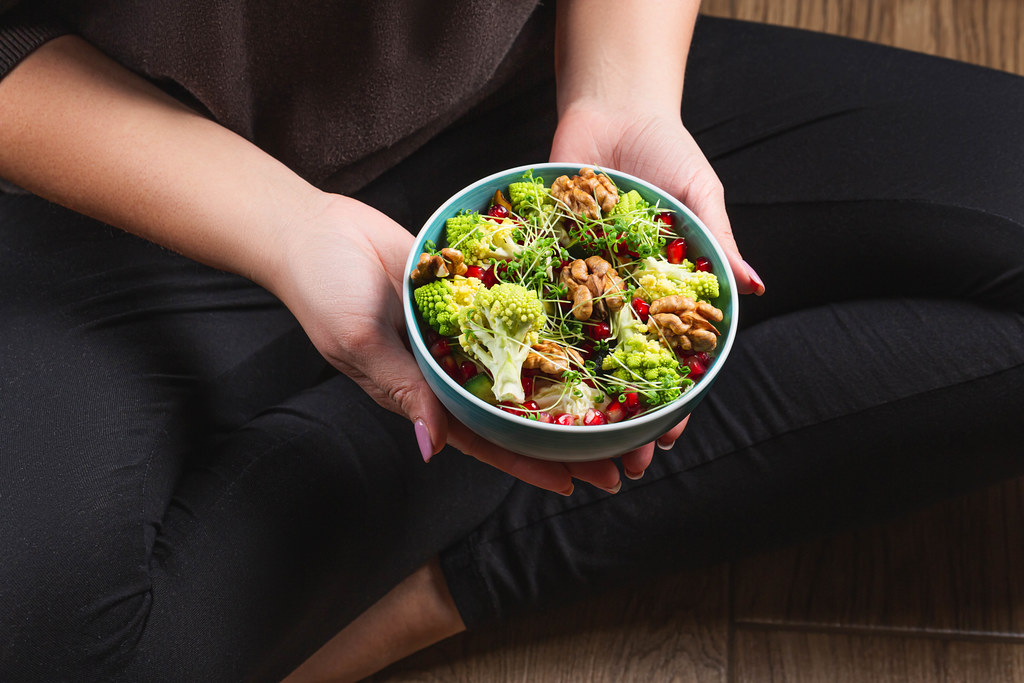As Hippocrates said in his time: “Let your food be your first medicine”.
Eating healthy is one of the keys to staying healthy! The food we ingest directly impacts all our cells and, more broadly, on who we are. What is less well known is that our morale is also directly linked to the way we eat: eating healthy can, among other things, reduce the risk of depression!
The good news is that sometimes all it takes is a few simple reflexes to change your diet.
Here is the proof of 8 easy tips to apply daily.
1. Put some color on your plate.
The key to eating healthier is to diversify your diet. Using color is a fun and straightforward solution. Antioxidants are known to come in the form of pigments of different shades. So multiply the colors in your plate to be sure to fill up on antioxidants. Antioxidants are vital because they help fight against many diseases.
– Yellow or orange fruits and vegetables provide beta-carotene and flavonoids: carrots, melons, sweet potatoes, apricots, etc.
– Green vegetables are sources of lutein and indoles: spinach, broccoli, green beans, green bell pepper, kiwi, etc.
– Blue-purple vegetables contain anthocyanins and phenolic compounds: eggplant, black grapes, blueberries, blackberries, etc.
– Red fruits and vegetables are rich in lycopene: tomatoes, beets, red fruits, etc.
– White fruits and vegetables contain sulfur compounds and polyphenols: garlic, onion, leek, banana, mushroom, etc.
However, to optimize the absorption rate of antioxidants (which are fat-soluble), they should be accompanied by fat. Even if a few drops of oil or olives can do the trick, the ideal is to combine them with avocado or, even better, with oil. Avocado oil increases alpha-carotene levels by 7.2, beta-carotene levels by 15.3, lutein levels by 5.1, and lycopene levels by 4.
Good to know: avoid white cereals (white bread, white pasta, etc.) and opt for “brown” cereals, i.e., whole grains (whole grain rice, whole grain pasta, whole grain, or integral bread). They are richer in fiber and minerals (they must be organic to avoid ingesting pesticides). They are therefore much better for transit and cardiovascular health.
2. Sprinkle spices and herbs on all your dishes.
Herbs and spices are excellent sources of antioxidants. Many spices are listed as the most antioxidant foods. In the first position, we find the clove, followed by cinnamon, turmeric, cumin, etc… Herbs are also rich in antioxidants, especially oregano, basil, parsley, sage, etc. Of course, we use them in tiny quantities, but they can quickly complete our daily needs if we sprinkle them in all our dishes.
Here are some herbs and spices rich in antioxidants, with their main properties:
– Cinnamon has an appetite suppressant effect. It helps regulate blood sugar and cholesterol levels.
– Cumin is ideal for relieving digestive disorders.
– Pepper activates blood circulation and relieves respiratory infections.
– Mint has painkilling and antibacterial properties.
– Parsley is a good source of vitamin C.
– Rosemary relieves joint pain.
– Thyme is particularly effective for colds and flu.
3. Eat fruits and vegetables with their skin.

A large part of plants’ minerals, vitamins, and fibers are found… in their skin! That’s why it’s best not to peel them. Ideally, you should choose organically grown fruits and vegetables to limit exposure to pesticide residues.
It is recommended to give preference to fruits and vegetables grown according to production methods that reduce exposure to pesticides and specifies that organic farming is a production method that limits inputs and is, therefore, a way to limit exposure to pesticides. Indeed, 72% of non-organic fruits and 43% of non-organic vegetables are contaminated by pesticide residues, several even exceeding the maximum residue limit (MRL).
Otherwise, be sure to wash your fruits and vegetables very carefully. Use a special vegetable brush and water with a pinch of baking soda.
Good to know: some fruits and vegetables are more contaminated by pesticide residues than others. The most treated fruits and vegetables (preferably organic): celery, cherries, spinach, strawberries, kiwi fruit, lettuce, nectarines, peaches, pears, peppers, apples, potatoes, and grapes.
4. Avoid processed foods.
Additives, colorings, preservatives… Industrial products are often full of chemicals to extend their shelf life, making them tastier or more flavorful. However, many of these additives are suspected of causing undesirable effects: allergies, intolerances, increased risk of obesity, or even cancer.
5. The solution to eating healthier: choose fresh and unprocessed products.

Vegetables, fruits, legumes, cereals, fish, and meat should be cooked according to your taste. The advantage is that all combinations are allowed, allowing you to discover unexpected flavors!
Good to know: the prevention component of the national health strategy 2018-2022 has set a goal of reducing the consumption of ultra-processed foods by 20% between 2018 and 2021. A French study indicates that a 10% increase in this type of food consumption would increase the risk of developing depressive symptoms by 21%.
6. Don’t skip the fats.
Contrary to popular belief, eating healthier does not necessarily mean cutting out fats. On the contrary, they are essential to the proper functioning of the body, including the manufacture of cells, the synthesis of hormones, the absorption of fat-soluble vitamins …
Some, such as omega-3, play a central role in preventing cardiovascular disease and mood regulation. It is mainly found in fatty fish, certain vegetable oils (rapeseed, walnut, flax), nuts, etc.
Another “good” source of essential fatty acids is olive oil, rich in omega-3. It plays a significant role in regulating cholesterol levels and is the primary product of the famous Mediterranean diet.
Good to know: make sure you consume 2 tablespoons of oil every day, varying the origin (olive oil for cooking, rapeseed oil for salads, etc.).
7. Choose your cooking methods carefully.
The cooking method changes the nutritional value of food. Even the healthiest food will lose its value if you don’t cook it properly.
For example, broccoli cooked in a large volume of boiling water will lose much of its valuable minerals and vitamins (soluble in water).
Here are some tips to follow when cooking:
– Always prefer gentle cooking, such as steaming (which also helps preserve flavors).
– Also, beware of cooking for too long, which turns complex carbohydrates into “fast” sugars.
– Also, limit roasted or caramelized cooking, which leads to the formation of advanced glycation products (which accelerate aging), especially barbecuing, which releases carcinogenic compounds.
Good to know: also be careful with the fats you choose for cooking. Some fats, such as flaxseed or walnut oil, should never be heated because they cause the formation of carcinogenic compounds. Olive oil or clarified butter are better.
8. Snacking: opt for oleaginous fruits.
Are you looking for healthy, filling snacks that are good for your figure and your health? Go for oily fruits: walnuts, hazelnuts, almonds, etc. They have many advantages.
– They are a source of good fats that provide polyunsaturated fatty acids, good for cardiovascular health. Walnuts are even an excellent source of omega-3.
– They are rich in fiber, suitable for transit, and prevent many diseases (cardiovascular diseases or diabetes).
– They provide antioxidants, mainly phenolic compounds, with protective virtues against many diseases.
– They are also good sources of phytosterols, anticholesterol compounds.
– They provide numerous minerals, notably magnesium, manganese, etc.
– They are rich in vegetable proteins.
A study has even shown that eating 20 g of nuts every day reduces the risk of heart disease by 30%, diabetes by 40%, cancer by 15%, and premature death by 22%.


